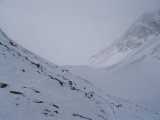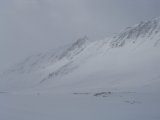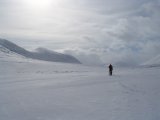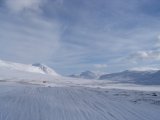Saturday 7/4

Kebnekaise – Sälka (via Tarfala/Guobirvággi)
| Horizontal distance: | 25 km |
| Vertical distance: | +800 m, -700 m |
| Time: | 7 h 45 min |
| Lunch break: | 1 h |
| Dinner: | Tortellini with meatballs and tomato sauce |
| Night accommodation: | Cottage |
| Stage classification: | Medium/Hard |
| Map points: | Kebnekaise, Tarfala, Sälka |
It was after 09:15 when Petter and I left Kebnekaise headed for Tarfala and beyond. Things were good at first, with no wind, warm temperatures and good sight. However, after a while a wind picked up and then clouds came in and started giving off some snow. We went higher than usual, aiming above the hanging snowdrift at the entrance to Darfálvággi, and before we passed into steep territory we put on our transceivers, just in case. The way down into the valley was somewhat tricky, since the perfectly flat light made it hard to judge how steep it really was, but it went all right.
Down in Darfálvággi going was very easy, and as we progressed upwards the clouds lifted to the west and south, but in front of us it was still white. After the turn we saw a large group going up the slope to our right, but we chose to go round it to the left instead, following in the tracks of a pair of skiers whom we had been chasing most of the way. It had started to clear – especially behind us – but the upper valley was shrouded yet, and after we had overtaken the other two people it was back to mist and snow – and wind. Things only got worse the higher we came, and by the time we reached the Tarfala cottage (11:30) we couldn't see much.
Inside we found Maj-Lis from Kaitumjaure, who together with Henry was filling a void in the warden schedule; Tarfala had turned out to be a real problem staffing-wise this season. As for ourselves we started having lunch in the common room, and shortly the two we had passed came in as well. While we sat there the clouds slowly lifted directly to the west, and the wind decreased. When we were preparing to leave Henry came back – he had been following a couple of Americans and another pair up towards the Gaskkasjávri pass to Guobirvággi, which we were planning to take too, so we seized the opportunity of updating ourselves on present conditions. We put on our climbing skins straight away and then set off across Darfáljávri.
Out on this frozen lake we met the two non-Americans, who had acted as guides to the pass point and were now returning; they said that visibility had been changing between bad and acceptable all the time, and that we should prepare for very hard gusts of wind – which came as no surprise. We proceeded up along the rightmost edge of the Giebmebákti glacier, staying clear of the crevices abundant in the central parts. A very weak sun showed itself through the veil above said glacier, and we could see well enough, even though the peaks were still in hiding. Down in the valley and the lower regions it was quite warm, but as we reached higher the wind started making itself known through keen gusts, and the snow that covered the ice was a bit devious at places.
Still, we had no particular trouble ascending, and even higher up we also had better sight – and harder wind. We maintained our altitude around Gaskkasjávri, which probably wasn't such a good idea – there were a great deal of bare rocks, and navigating between them was at times very awkward. A further complication was the onset of extremely hard gales, during which the snow they whirled up obscured everything but the nearby stones, but we pressed on just the same.
Once over the crest conditions improved noticeably, and we could make out Drakryggen (Dragonback) fairly clearly. Going down went well at first, but then one of my skins came loose and I fell, and after another abruptly failed attempt I saw fit to remove them altogether (I should probably have done it before even starting the descent, but there you go), and Petter followed suit. Down in the flat region beneath Passglaciären (Pass Glacier) we came upon some fresh tracks, which conceivably had an American source, so we followed those down to the next slope, thinking that either a) it was a safe route, or b) we'd end up performing avalanche rescue.
As expected the former was true, and once in the slope we made our own way; the snow was very good, and it was rather fun. We didn't go all the way down at once, however, but instead turned off towards the west, using our altitude to carry us past the uppermost part of Guobirvággi. By then visibility was good, and the acute grandeur of the landscape descended upon us. Down in the valley it was windless at first, which turned into gusts, and the gusts eventually developed into a steady tailwind, so the subsequent portion across the flat expanse was very easy and comfortable. When the ground was about to start sloping downwards we stopped for a light snack, looking out over the western landscape which was getting clearer by the minute.
Soon we found the Americans' tracks again, but also this time we left them for what we considered a better route, crossing a stream at a well selected place – in both directions there was an impassable ravine. We then stayed high up the northern slope, striving against an increasing headwind and unintentionally chasing a small herd of reindeer in front of us, while conditions worsened behind us. At the end of the valley the wind subsided, and we stood there watching Čeakčavággi stretch about below us; it was a mighty fine sight, and an unusual perspective much different from that of Kungsleden.
We then proceeded around the western end of Duolbanjunečohkka, passing into another region of considerable headwind, but as we still had the advantage of altitude the remaining bit to the reindeer fence was easy enough. We crossed this fence where it opens for the winter trail, and then stayed on the wide track for the final few kilometers. Those kilometers were, however, a bit draining, which was probably a combination of the long and demanding stage of the day and the impeding wind – but it was also a very beautiful portion, with all-white fjelds all around and direct sunlight.
We arrived at the Sälka cottages shortly after 17, and the warden who by now knew me very well was a bit surprised at yet another appearance. There were a fair number of people – and dogs – present, and another five of the bipedal kind were on the way from the north. Petter and I elected to stay in the same cottage as I had chosen last time, where there was a smaller group of Germans presently. After dumping our packs we went to the mini-store and purchased quite a few items, and then Petter went to the sauna-in-progress while I prepared dinner; I was saving myself for Alesjaure the next day. By then it had cleared almost completely in all directions, but a somewhat gusty northerly wind remained. Petter came back just as the food was ready, and we had a good and nourishing meal after a long day.
The evening was very fair with a bit of fresh cloud come out of the north, and the wind had almost disappeared. We rested in our room while the Germans did loud things in the common room, and during this time two Japanese people came in too. Petter saw me making notes for this diary of sorts, and asked to say hi – which is hereby conveyed. We played the card game I had learnt from some other Germans during my first tour, and then we just took it easy lying on our respective beds, eating some newly acquired potato chips and discussing various topics. Eventually we decided that we might just as well go to bed for real, which occurred at 22:00.














































